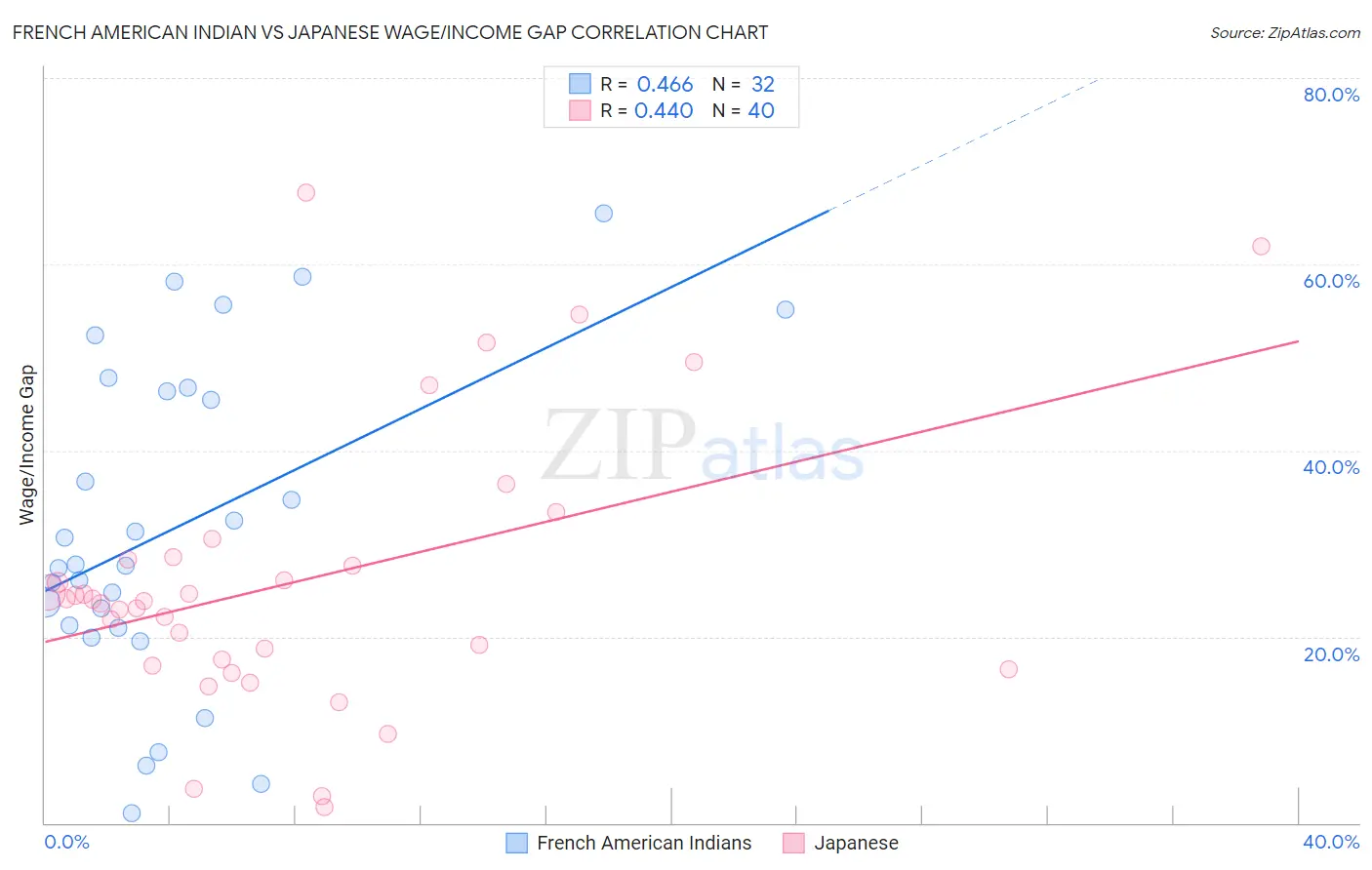French American Indian vs Japanese Wage/Income Gap
COMPARE
French American Indian
Japanese
Wage/Income Gap
Wage/Income Gap Comparison
French American Indians
Japanese
25.4%
WAGE/INCOME GAP
72.5/ 100
METRIC RATING
160th/ 347
METRIC RANK
23.8%
WAGE/INCOME GAP
99.1/ 100
METRIC RATING
101st/ 347
METRIC RANK
French American Indian vs Japanese Wage/Income Gap Correlation Chart
The statistical analysis conducted on geographies consisting of 131,928,964 people shows a moderate positive correlation between the proportion of French American Indians and wage/income gap percentage in the United States with a correlation coefficient (R) of 0.466 and weighted average of 25.4%. Similarly, the statistical analysis conducted on geographies consisting of 249,130,971 people shows a moderate positive correlation between the proportion of Japanese and wage/income gap percentage in the United States with a correlation coefficient (R) of 0.440 and weighted average of 23.8%, a difference of 6.6%.

Wage/Income Gap Correlation Summary
| Measurement | French American Indian | Japanese |
| Minimum | 1.1% | 1.7% |
| Maximum | 65.5% | 67.8% |
| Range | 64.4% | 66.0% |
| Mean | 31.7% | 26.0% |
| Median | 27.7% | 23.9% |
| Interquartile 25% (IQ1) | 21.1% | 17.2% |
| Interquartile 75% (IQ3) | 46.5% | 28.4% |
| Interquartile Range (IQR) | 25.5% | 11.2% |
| Standard Deviation (Sample) | 17.2% | 14.8% |
| Standard Deviation (Population) | 17.0% | 14.6% |
Similar Demographics by Wage/Income Gap
Demographics Similar to French American Indians by Wage/Income Gap
In terms of wage/income gap, the demographic groups most similar to French American Indians are Puget Sound Salish (25.3%, a difference of 0.040%), Immigrants from Zimbabwe (25.3%, a difference of 0.10%), Albanian (25.4%, a difference of 0.26%), Costa Rican (25.3%, a difference of 0.28%), and Shoshone (25.4%, a difference of 0.28%).
| Demographics | Rating | Rank | Wage/Income Gap |
| Blackfeet | 78.1 /100 | #153 | Good 25.2% |
| Immigrants | Northern Africa | 78.1 /100 | #154 | Good 25.2% |
| Immigrants | Vietnam | 77.7 /100 | #155 | Good 25.2% |
| Immigrants | Mexico | 76.4 /100 | #156 | Good 25.3% |
| Costa Ricans | 75.8 /100 | #157 | Good 25.3% |
| Immigrants | Zimbabwe | 73.7 /100 | #158 | Good 25.3% |
| Puget Sound Salish | 73.0 /100 | #159 | Good 25.3% |
| French American Indians | 72.5 /100 | #160 | Good 25.4% |
| Albanians | 69.4 /100 | #161 | Good 25.4% |
| Shoshone | 69.0 /100 | #162 | Good 25.4% |
| Native Hawaiians | 69.0 /100 | #163 | Good 25.4% |
| Koreans | 68.6 /100 | #164 | Good 25.4% |
| Immigrants | Hong Kong | 64.0 /100 | #165 | Good 25.5% |
| Immigrants | Ukraine | 63.8 /100 | #166 | Good 25.5% |
| Paiute | 62.9 /100 | #167 | Good 25.5% |
Demographics Similar to Japanese by Wage/Income Gap
In terms of wage/income gap, the demographic groups most similar to Japanese are Immigrants from Laos (23.8%, a difference of 0.14%), Yakama (23.7%, a difference of 0.15%), Aleut (23.7%, a difference of 0.17%), Immigrants from Latin America (23.7%, a difference of 0.25%), and Tsimshian (23.9%, a difference of 0.37%).
| Demographics | Rating | Rank | Wage/Income Gap |
| Hondurans | 99.5 /100 | #94 | Exceptional 23.6% |
| Cape Verdeans | 99.4 /100 | #95 | Exceptional 23.6% |
| Kiowa | 99.4 /100 | #96 | Exceptional 23.6% |
| Immigrants | Sudan | 99.4 /100 | #97 | Exceptional 23.6% |
| Immigrants | Latin America | 99.2 /100 | #98 | Exceptional 23.7% |
| Aleuts | 99.2 /100 | #99 | Exceptional 23.7% |
| Yakama | 99.2 /100 | #100 | Exceptional 23.7% |
| Japanese | 99.1 /100 | #101 | Exceptional 23.8% |
| Immigrants | Laos | 99.0 /100 | #102 | Exceptional 23.8% |
| Tsimshian | 98.9 /100 | #103 | Exceptional 23.9% |
| Tlingit-Haida | 98.7 /100 | #104 | Exceptional 24.0% |
| Moroccans | 98.6 /100 | #105 | Exceptional 24.0% |
| Sudanese | 98.6 /100 | #106 | Exceptional 24.0% |
| Yaqui | 98.4 /100 | #107 | Exceptional 24.0% |
| Immigrants | Albania | 98.4 /100 | #108 | Exceptional 24.0% |